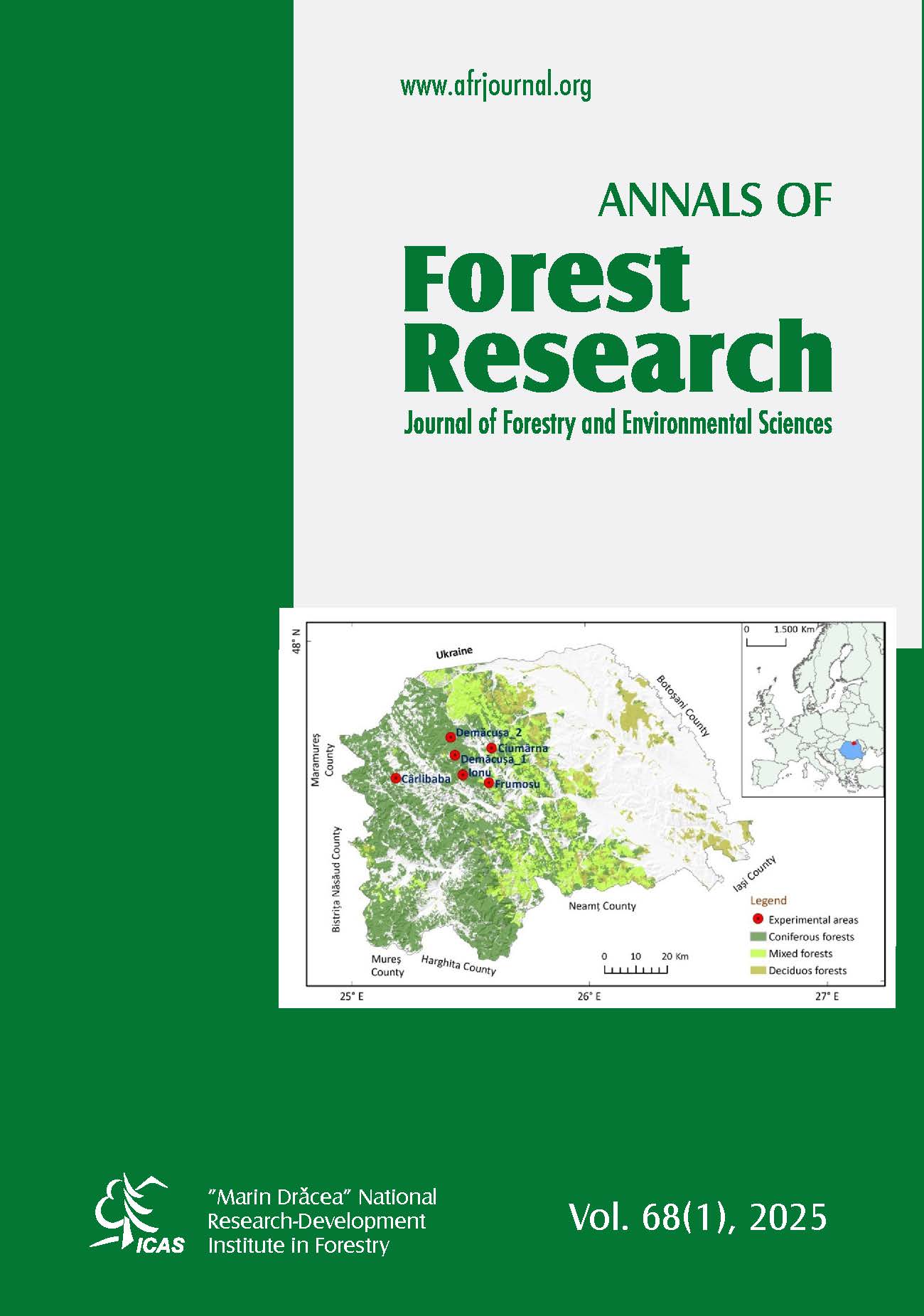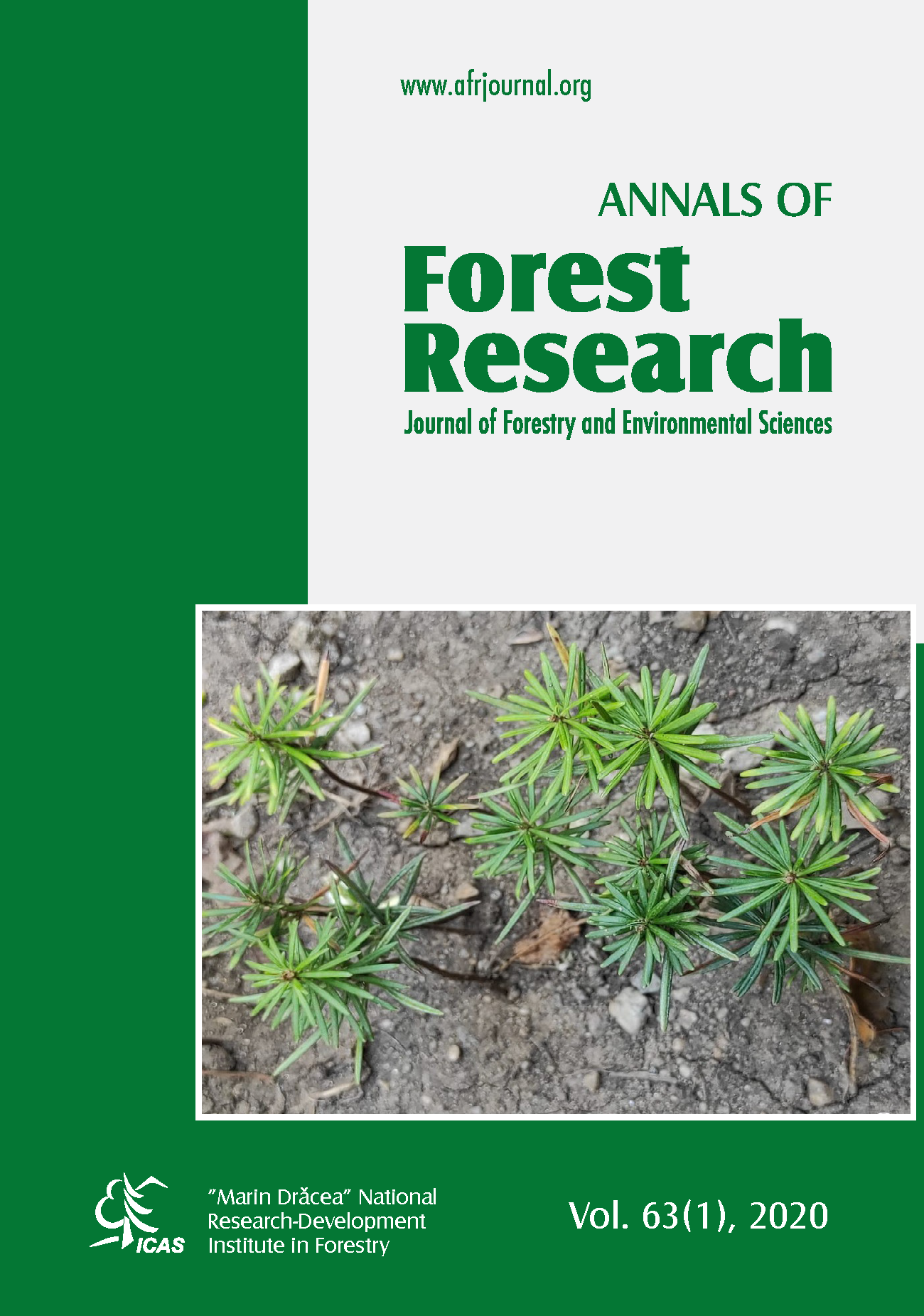Fertility variability among clones and genetic diversity of seed crops at seed orchards of Chamaecyparis obtusa in South Korea
DOI:
https://doi.org/10.15287/afr.2025.3820Keywords:
Japanese cypress, gene diversity, fertility variation, genetic parameter, effective parent number, cone productionAbstract
Chamaecyparis obtusa (Siebold & Zucc.) Endl., commonly known as Japanese cypress or hinoki cypress, is widely cultivated for its high-quality timber and ornamental use. Despite its economic and ecological importance, the species faces challenges in adapting to various climates, necessitating the distribution of high-quality seeds and seedlings. This study aims to enhance the genetic improvement and stability of seed production by analyzing fertility characteristics and genetic traits from two clonal seed orchards of C. obtusa in two locations (Gochang and Seogwipo), South Korea. We examined patterns of strobilus and cone production from 2020 to 2022, assessed effective parent numbers, genetic diversity, and heritability estimates, and analyzed parental contribution for the reproductive traits. Results indicated significant annual variation in strobilus and cone production among clones, with higher male fertility variance than female parents. The effective parent number and genetic diversity were generally maintained sustainably, though Seogwipo showed slightly lower diversity. The study underscores the need for management practices to balance clonal contributions, and sustain long-term productivity and genetic diversity in the seed orchards of C. obtusa. Future research should focus on understanding environmental influences on clonal contributions and refining selection criteria for superior clones in the advanced generation breeding program.
References
Apsit VJ., Nakamura RR., Wheeler N.C., 1989. Differential male reproductive success in Douglas fir. Theor Appl Genet 77: 681–684.
Bottero A., Moos C., Stritih A., Teich M., 2024. Editorial: Impacts of global change on protective forests in mountain areas. Front For Glob Change 7. https://doi.org/10.3389/ffgc.2024.1375285
Burczyk J., Chalupka W., 1997. Flowering and cone production variability and its effect on parental balance in a Scots pine clonal seed orchard. Annales des Sciences Forestières. EDP Sciences.
Burczyk J., Chybicki I.J., 2004. Cautions on direct gene flow estimation in plant populations. Evolution 58: 956–963. https://doi.org/10.1111/j.0014-3820.2004.tb00430.x
Burczyk J., DiFazio S., Adams W., 2004a. Gene flow in forest trees: how far do genes really travel? For Genet 11: 179.
Burczyk J., Lewandowski A., Chalupka W., 2004b. Local pollen dispersal and distant gene flow in Norway spruce (Picea abies [L.] Karst.). For Ecol Manag 197: 39–48. https://doi.org/10.1016/j.foreco.2004.05.003
Chaisurisri K., El-Kassaby Y.A., 1993. Estimation of clonal contribution to cone and seed crops in a Sitka spruce seed orchard. Annales des sciences forestières. EDP Sciences.
Chaloupková K., Lstibůrek M., 2022. Spatial optimization of genetic thinning in seed orchards. Ann For Sci 79: 37. https://doi.org/10.1186/s13595-022-01158-4
Choi H-S., Kang Y-J., Kim I-S., et al., 2012. Growth and heritability of Hinoki Cypress (Chamaecyparis obtusa) families in Jeju. Korean J Agric For Meteorol 14: 236–245.
Cortés A.J., Restrepo-Montoya M., Bedoya-Canas L.E., 2020. Modern Strategies to Assess and Breed Forest Tree Adaptation to Changing Climate. Front Plant Sci 11: 583323. https://doi.org/10.3389/fpls.2020.583323
El-Kassaby Y.A., 1995. Evaluation of the tree-improvement delivery system: factors affecting genetic potential. Tree Physiol 15: 545–550.
El-Kassaby Y.A., Askew G.R., 1991. The relation between reproductive phenology and reproductive output in determining the gametic pool profile in a Douglas-fir seed orchard. For Sci 37: 827–835.
El-Kassaby Y.A., Cook C., 1994. Female reproductive energy and reproductive success in a Douglas-fir seed orchard and its impact on genetic diversity. Silvae Genet 43: 243–245.
El-Kassaby Y.A., Ritland K., 1986. Low levels of pollen contamination in a Douglas-fir seed orchard as detected by allozyme markers. Silvae Genet 35: 224–229.
El-Kassaby Y.A., Ritland K., 1992. Frequency-dependent male reproductive success in a polycross of Douglas fir. Theor Appl Genet 83: 752–758. https://doi.org/10.1007/BF00226694
Eltayeb L.M., Yagi S., Mohamed H.M., et al., 2023. Essential oils composition and biological activity of Chamaecyparis obtusa, Chrysopogon nigritanus and Lavandula coronopifolia grown wild in Sudan. Molecules 28: 1005. https://doi.org/10.3390/molecules28031005
Eriksson G., Jonsson A., Lindgren D., 1973. Flowering in a clone trial of Picea abies Karst. Studia Forestalia Suecica. Nr.110, 45pp.
Eriksson G., Schelander B., Åkebrand V., 1973. Inbreeding depression in an old experimental plantation of Picea abies. Hereditas 73: 185–193.
Foster G.S., 1992. Estimating yield: beyond breeding values. Handbook of quantitative forest genetics. Springer.
Fries A., 1994. Development of flowering and the effect of pruning in a clonal seed orchard of lodgepole pine. Can J For Res 24(1): 71-76. https://doi.org/10.1139/x94-011
Funda T., El-Kassaby Y.A., 2012. Seed orchard genetics. CABI Rev 1–23.
Funda T., Lstibůrek M., Lachout P., et al., 2009. Optimization of combined genetic gain and diversity for collection and deployment of seed orchard crops. Tree Genet Genomes 5: 583–593. https://doi.org/10.1007/s11295-009-0211-3
Gamba D., Muchhala N., 2020. Global patterns of population genetic differentiation in seed plants. Mol Ecol 29: 3413–3428. https://doi.org/10.1111/mec.15575
Górski K.M., Kowalczyk T., Picot L., et al., 2024. The Precious potential of the sacred tree Chamaecyparis obtusa (Siebold & Zucc.) Endl. as a source of secondary metabolites with broad biological applications. Int J Mol Sci 25: 2723. https://doi.org/10.3390/ijms25052723
Grattapaglia D., Silva-Junior O.B., Resende R.T., et al., 2018. Quantitative genetics and genomics converge to accelerate forest tree breeding. Front Plant Sci 9: 1693. https://doi.org/10.3389/fpls.2018.01693
Havens T.R., 2020. Land of plants in motion: Japanese botany and the world. University of Hawaii Press.
Hong S.K., 1969. Forestry in Korea.
Isik F., McKeand S.E., 2019. Fourth cycle breeding and testing strategy for Pinus taeda in the NC State University Cooperative Tree Improvement Program. Tree Genet Genomes 15: 70. https://doi.org/10.1007/s11295-019-1377-y
Jang Y-A., Kim S-G., Kim H-K., Lee J-T., 2023. Biological Activity and Component Analyses of Chamaecyparis obtusa Leaf Extract: Evaluation of Antiwrinkle and Cell Protection Effects in UVA-Irradiated Cells. Medicina (Mex) 59: 755. https://doi.org/10.3390/medicina59040755
Jang-Hwan J., So-Hee P., JaChoon K., et al., 2020. Preferences for ecosystem services provided by urban forests in South Korea. For Sci Technol 16: 86–103. https://doi.org/10.1080/21580103.2020.1762761
Kang K-S., 2001. Genetic gain and gene diversity of seed orchard crops. Silvestria 187, 75pp.
Kang K-S., Bilir N., Jeon K., Kim Y-J., 2023. Fertility Variation and Gene Diversity in Forest Populations. Forests 14: 2172. https://doi.org/10.3390/f14112172
Kang K-S., El-Kassaby Y., 2002. Considerations of correlated fertility between genders on genetic diversity: the Pinus densiflora seed orchard as a model. Theor Appl Genet 105: 1183–1189. https://doi.org/10.1007/s00122-002-1064-4
Kang K-S., Mullin T.J., 2007. Variation in clone fertility and its effect on the gene diversity of seeds from a seed orchard of Chamaecyparis obtusa in Korea. Silvae Genet 56: 134–137.
Kang D-B., Sung J.W., Lee D-H., 2021. Effects of shading and fertilizer treatments on the growth characteristics of Chamaecyparis obtusa (S. et Z.) Endlicher seedlings. For Sci Technol 17: 125–134. https://doi.org/10.1080/21580103.2021.1957722
Kim K., Zsuffa L., 1994. Reforestation of South Korea: The history and analysis of a unique case in forest tree improvement and forestry. For Chron 70: 58–64.
Lee K.Y., Han Y.C., Ryu K.O., et al., 1986. Growth of open-pollinated progeny of Chamaecyparis obtusa plus trees introduced from Japan. Res Rep Inst For Genet Korea Repub 111–115.
Lee I-K., Kang Y-J., Kim C-S., Kim Y-K., 2006. Effects of Thinning on Soil Properties and Seed Productivity in Seed Orchards of Cryptomeria japonica and Chamaecyparis obtusa. J Ecol Environ 29: 495–501. https://doi.org/10.5141/JEFB.2006.29.6.495
Lenz P.R., Nadeau S., Azaiez A., et al., 2020. Genomic prediction for hastening and improving efficiency of forward selection in conifer polycross mating designs: an example from white spruce. Heredity 124: 562–578. https://doi.org/10.1038/s41437-019-0290-3
Li Y., Li X., Zhao M-H., et al., 2021. An overview of the practices and management methods for enhancing seed production in conifer plantations for commercial use. Horticulturae 7: 252. https://doi.org/10.3390/horticulturae7080252
Lindgren D., Mullin T.J., 1998. Relatedness and status number in seed orchard crops. Can J For Res 28(2): 276-283. https://doi.org/10.1139/x97-217
Matziris D.I., 1994. Genetic Variation in the Phenology of Flowering in Black Pine. Silvae Genetica 43(5): 321-328.
Maruyama E., Ishii K., Hosoi Y., 2005. Efficient plant regeneration of Hinoki cypress (Chamaecyparis obtusa) via somatic embryogenesis. J For Res 10: 73–77. https://doi.org/10.1007/s10310-004-0105-z
Nakashizuka T., 2009. Sustainability and Diversity of Forest Ecosystems. Springer.
Namkoong G., Kang H., Brouard J., 1988. Tree Breeding: Principles and Strategies. Springer-Verlag. N Y.
Namkoong G., Kang H-C., Brouard J.S., 2012. Tree breeding: principles and strategies: principles and strategies. Springer Science & Business Media.
Na S.J., Lee H.S., Han S.U., et al., 2015. Estimation of genetic gain and diversity under various genetic thinning scenarios in a breeding seed orchard of Quercus acutissima. Scand J For Res 30: 377-381. https://doi.org/10.1080/02827581.2015.1018936
Nikkanen T., Ruotsalainen S., 2000. Variation in flowering abundance and its impact on the genetic diversity of the seed crop in a Norway spruce seed orchard. Silva Fennica 34(3): 205–222. https://doi.org/10.14214/sf.626
Orji K., Mbah E., Akpan A., 2022. Agroforestry: A review of its importance, problems and prospects in crop production. Ratarstvo I povrtarstvo 59(3): 64-75. DOI: 10.5937/ratpov59-39353
Pakull B., Eusemann P., Wojacki J., et al., 2021. Genetic diversity of seeds from four German Douglas fir (Pseudotsuga menziesii) seed orchards. Eur J For Res 140: 1543–1557. https://doi.org/10.1007/s10342-021-01419-3
Park K-H., 2022. Analysis of urban forest healing program expected values, needs, and preferred components in urban forest visitors with diseases: A pilot survey. Int J Environ Res Public Health 19: 513. DOI: 10.3390/ijerph19010513
Park J-M., Kang H-I., Yeom D-B., et al., 2020. Gender, reproductive output covariation and their role on gene diversity of Pinus koraiensis seed orchard crops. BMC Plant Biol 20: 418. https://doi.org/10.1186/s12870-020-02632-9
Park S., Kim S., Kim G., et al., 2021. Evidence-based status of forest healing program in South Korea. Int J Environ Res Public Health 18: 10368. https://doi.org/10.3390/ijerph181910368
Reynolds S., El-Kassaby Y.A., 1990. Parental balance in Douglas-fir seed orchards-cone crop vs. seed crop. Silvae Genet 39: 40–42.
Rosvall O., Mullin T.J., Lindgren D., 2003. Controlling parent contributions during positive assortative mating and selection increases gain in long-term forest tree breeding. For Genet 10: 35-53.
Sharma C.M., Khanduri V.P., 2012. Pollen cone characteristics, pollen yield and pollen-mediated gene flow in Cedrus deodara. Curr Sci 102: 394–397. https://www.jstor.org/stable/24083884
Shin J.H., Park P.S., Lee D.K., 2007. Forest restoration in Korea. Keep Asia Green 2: 55–79.
Wang F., Zhang S., Zhu P., et al., 2023. The effects of fertility and synchronization variation on seed production in two Chinese fir clonal seed orchards. Sci Rep 13: 627. https://doi.org/10.1038/s41598-022-27151-5
Yang J., Mezmouk S., Baumgarten A., et al., 2017. Incomplete dominance of deleterious alleles contributes substantially to trait variation and heterosis in maize. PLoS Genet 13: e1007019. https://doi.org/10.1371/journal.pgen.1007019
Zhang X., Yu M., Su J., et al., 2024. Leaf nutrient traits of planted forests demonstrate a heightened sensitivity to environmental changes compared to natural forests. Front Plant Sci 15: 1372530. https://doi.org/10.3389/fpls.2024.1372530
Downloads
Published
Issue
Section
License
All the papers published in Annals of Forest Research are available under an open access policy (Gratis Gold Open Access Licence), which guaranty the free (of taxes) and unlimited access, for anyone, to entire content of the all published articles. The users are free to "read, copy, distribute, print, search or refers to the full text of these articles", as long they mention the source.
The other materials (texts, images, graphical elements presented on the Website) are protected by copyright.
The journal exerts a permanent quality check, based on an established protocol for publishing the manuscripts. The potential article to be published are evaluated (peer-review) by members of the Editorial Board or other collaborators with competences on the paper topics. The publishing of manuscript is free of charge, all the costs being supported by Forest Research and Management Institute.
More details about Open Access:
Wikipedia: http://en.wikipedia.org/wiki/Open_access






